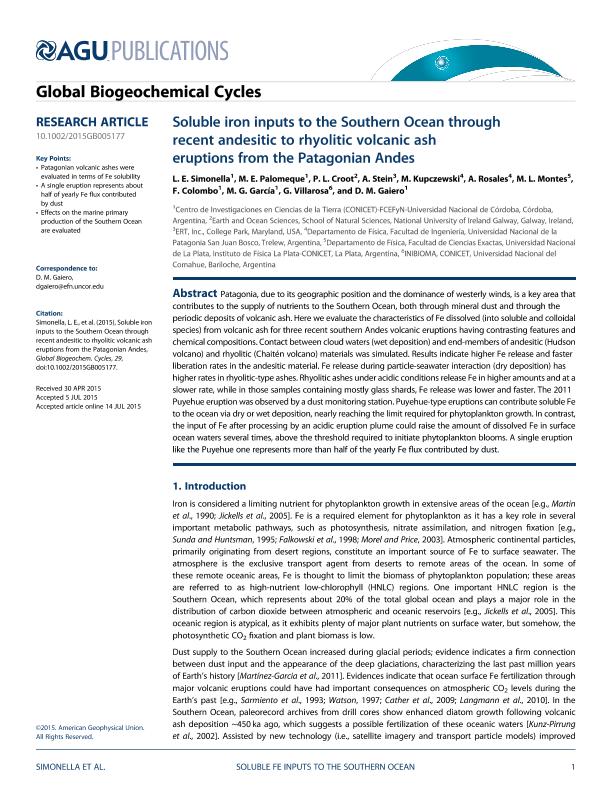Mostrar el registro sencillo del ítem
dc.contributor.author
Simonella, Lucio Esteban

dc.contributor.author
Palomeque, M. E.
dc.contributor.author
Croot, P. L.
dc.contributor.author
Stein, A.
dc.contributor.author
Kupckezewski, M.
dc.contributor.author
Rosales, A.
dc.contributor.author
Montes, María Luciana

dc.contributor.author
Colombo, Fernando

dc.contributor.author
Garcia, Maria Gabriela

dc.contributor.author
Villarosa, Gustavo

dc.contributor.author
Gaiero, Diego Marcelo

dc.date.available
2017-02-02T16:02:54Z
dc.date.issued
2015-07
dc.identifier.citation
Simonella, Lucio Esteban; Palomeque, M. E.; Croot, P. L.; Stein, A.; Kupckezewski, M.; et al.; Soluble iron inputs to the Southern Ocean through recent andesitic to rhyolitic volcanic ash eruptions from the Patagonian Andes; American Geophysical Union; Global Biogeochemical Cycles; 29; 8; 7-2015; 1125-1144
dc.identifier.issn
0886-6236
dc.identifier.uri
http://hdl.handle.net/11336/12360
dc.description.abstract
Patagonia, due to its geographic position and the dominance of westerly winds, is a key area that contributes to the supply of nutrients to the Southern Ocean, both through mineral dust and through the periodic deposits of volcanic ash. Here we evaluate the characteristics of Fe dissolved (into soluble and colloidal species) from volcanic ash for three recent southern Andes volcanic eruptions having contrasting features and chemical compositions. Contact between cloud waters (wet deposition) and end-members of andesitic (Hudson volcano) and rhyolitic (Chaitén volcano) materials was simulated. Results indicate higher Fe release and faster liberation rates in the andesitic material. Fe release during particle-seawater interaction (dry deposition) has higher rates in rhyolitic-type ashes. Rhyolitic ashes under acidic conditions release Fe in higher amounts and at a slower rate, while in those samples containing mostly glass shards, Fe release was lower and faster. The 2011 Puyehue eruption was observed by a dust monitoring station. Puyehue-type eruptions can contribute soluble Fe to the ocean via dry or wet deposition, nearly reaching the limit required for phytoplankton growth. In contrast, the input of Fe after processing by an acidic eruption plume could raise the amount of dissolved Fe in surface ocean waters several times, above the threshold required to initiate phytoplankton blooms. A single eruption like the Puyehue one represents more than half of the yearly Fe flux contributed by dust.
dc.format
application/pdf
dc.language.iso
eng
dc.publisher
American Geophysical Union

dc.rights
info:eu-repo/semantics/openAccess
dc.rights.uri
https://creativecommons.org/licenses/by-nc-sa/2.5/ar/
dc.subject
Volcanic Ash
dc.subject
Patagonia
dc.subject
Dust
dc.subject
Southern Ocean
dc.subject.classification
Vulcanología

dc.subject.classification
Ciencias de la Tierra y relacionadas con el Medio Ambiente

dc.subject.classification
CIENCIAS NATURALES Y EXACTAS

dc.title
Soluble iron inputs to the Southern Ocean through recent andesitic to rhyolitic volcanic ash eruptions from the Patagonian Andes
dc.type
info:eu-repo/semantics/article
dc.type
info:ar-repo/semantics/artículo
dc.type
info:eu-repo/semantics/publishedVersion
dc.date.updated
2016-12-12T14:32:36Z
dc.journal.volume
29
dc.journal.number
8
dc.journal.pagination
1125-1144
dc.journal.pais
Estados Unidos

dc.description.fil
Fil: Simonella, Lucio Esteban. Consejo Nacional de Investigaciones Científicas y Técnicas. Centro Científico Tecnológico Córdoba. Centro de Investigaciones En Ciencias de la Tierra; Argentina. Universidad Nacional de Córdoba; Argentina
dc.description.fil
Fil: Palomeque, M. E.. Consejo Nacional de Investigaciones Científicas y Técnicas. Centro Científico Tecnológico Córdoba. Centro de Investigaciones En Ciencias de la Tierra; Argentina. Universidad Nacional de Córdoba; Argentina
dc.description.fil
Fil: Croot, P. L.. National University of Ireland Galway; Irlanda
dc.description.fil
Fil: Stein, A.. Ert Inc.; Estados Unidos
dc.description.fil
Fil: Kupckezewski, M.. Universidad Nacional de la Patagonia; Argentina
dc.description.fil
Fil: Rosales, A.. Universidad Nacional de la Patagonia; Argentina
dc.description.fil
Fil: Montes, María Luciana. Universidad Nacional de la Plata. Facultad de Ciencias Exactas. Departamento de Física; Argentina
dc.description.fil
Fil: Colombo, Fernando. Consejo Nacional de Investigaciones Científicas y Técnicas. Centro Científico Tecnológico Córdoba. Centro de Investigaciones En Ciencias de la Tierra; Argentina. Universidad Nacional de Córdoba; Argentina
dc.description.fil
Fil: Garcia, Maria Gabriela. Consejo Nacional de Investigaciones Científicas y Técnicas. Centro Científico Tecnológico Córdoba. Centro de Investigaciones En Ciencias de la Tierra; Argentina. Universidad Nacional de Córdoba; Argentina
dc.description.fil
Fil: Villarosa, Gustavo. Consejo Nacional de Investigaciones Científicas y Técnicas. Centro Científico Tecnológico Patagonia Norte. Instituto de Investigación En Biodiversidad y Medioambiente; Argentina. Universidad Nacional del Comahue; Argentina
dc.description.fil
Fil: Gaiero, Diego Marcelo. Consejo Nacional de Investigaciones Científicas y Técnicas. Centro Científico Tecnológico Córdoba. Centro de Investigaciones En Ciencias de la Tierra; Argentina. Universidad Nacional de Córdoba; Argentina
dc.journal.title
Global Biogeochemical Cycles

dc.relation.alternativeid
info:eu-repo/semantics/altIdentifier/url/http://onlinelibrary.wiley.com/doi/10.1002/2015GB005177/full
dc.relation.alternativeid
info:eu-repo/semantics/altIdentifier/url/http://dx.doi.org/10.1002/2015GB005177
Archivos asociados
